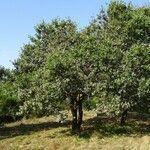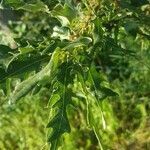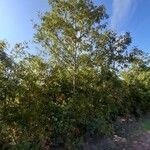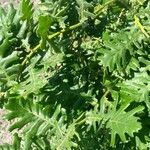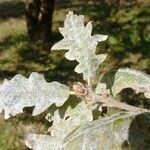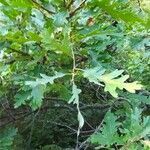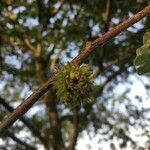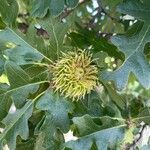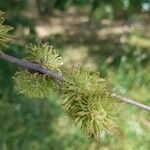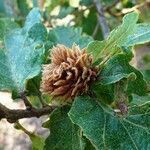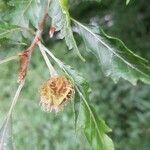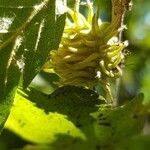Large deciduous tree (to c. 25 m tall in cultivation), with strongly fissured grey bark. Shoots ± tomentose when young. Buds hairy, surrounded by hairy, long-filiform, persistent stipules. Petiole to c. 2 cm long, hairy. Lamina on adult shoots 6-14 × 2-8 cm, oblong-lanceolate to oblong-obovate, with 5-8 pairs of lobes or teeth, sometimes lyrate-pinnatifid, whitish or grey-tomentose beneath (hairs simple or stellate), glabrescent and ± shining above with scattered stellate hairs, somewhat viscid when very young, membranous, cuneate at base; lobes varying from deep to shallow, sometimes extending almost to midrib, with teeth obtuse, acute or mucronate. ♂ catkins slender, to 8 cm long, densely hairy; stamens usually 4; perianth > filaments. Fr. in clusters of 1-4 fertile ones, reaching maturity in second year, subsessile or with pedicel very short; peduncle 0. Cup 2-2.5 cm diam.; scales subulate, spreading or recurved, hairy. Acorn 2-2.3 cm long, oblong-ovoid, < 1/2 enclosed by cup.
More
A large tree which loses its leaves. It grows to 38 m high. It has a large broad crown. The bark is cracked and rough. The leaves are alternate. They have deeply cut lobes. They are rough, dark green and shiny on top. There are leafy stipules around the leaf base. The flowers are separately male and female. The male flowers hang in dense bunches and the female flowers are small. The acorns are produced in very mossy cups.
The nuts are bitter. They can be leached, ground into flour and made into bread. They are used to make coffee. A coccus insect causes the plant to exude a sweet fluid which hardens and this is dipped in water to make a syrupy drink. The syrup can be boiled down or used for sweetening food. The fruit are fried and eaten. They are used as a coffee substitute after leaching and roasting. The leaves are put into stored cucumbers as a spice.
